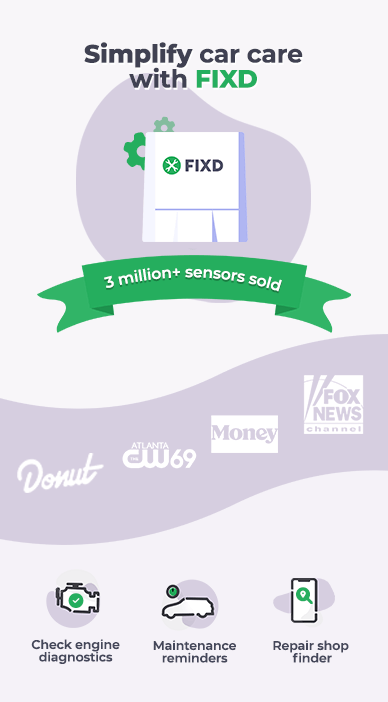When To Replace A Car Battery
In general, most car batteries last 3-5 years, depending on the battery and your vehicle. While extremely hot or cold temperatures are especially hard on your car battery, even if you take every precaution to winterize it and care for it during summer, it will still wear out at some point.
Since the cost to replace a car battery isn’t cheap, it’s best to know how to replace your battery yourself.
To get ahead of a dead car battery and avoid embarrassing parking lot breakdowns, pay attention to the signs of a weak car battery. It also wouldn’t hurt to set up a wear item alert inside the FIXD app. FIXD will let you know when it’s time to replace your battery so you don’t get stranded.
>> Click here to get FIXD for $19.99!
Signs Of A Weak Car Battery
- Car cranks or clicks but won’t start
- Slow to start
- Engine starts but won’t stay running
- Dim headlights or lack of power to electronics
- Dash lights work but car won’t start
- Heavy corrosion at the terminals
- Rotten egg smell
- Out of date battery (check manufacture date on the battery case)
Alternatively, if you see a battery light on your dash while driving the car, this probably doesn’t mean there’s a problem with your battery. More likely, this could be a sign of other battery-related issues such as a failing alternator or required maintenance like a poor body ground wire or excessive corrosion on the terminals.

How To Test Your Car Battery Voltage
A battery is considered fully charged at 12.6 volts or higher. Even the slightest drop in voltage can make a big difference in the vehicle. At 12.4 volts, the battery is considered charged, but only at 75%. If the battery reads 12 volts and below, the car may not start. A battery by industry standard is considered discharged at 12.39 volts or less.
A surefire way to find out if your car battery is dying is to test the voltage with a car battery tester or volt meter. Or you can simply use your FIXD Sensor to test your battery at home!
Most newer vehicle batteries are connected directly to the OBD-II port, allowing a versatile car scanner like the FIXD Sensor to read the battery and measure the voltage in seconds.
Plus, if there are any other issues with your car’s engine components related to the charging system, many times there will be a fault stored, and the FIXD OBD2 scanner will be able to pull these codes to tell you what the faults are in plain English.
Battery voltage good? Let the FIXD app track your battery life for you and send you an automated alert when it’s time for a new one.

Dead Car Battery Charge Or Replace?
If your battery died because you simply left the lights on, follow these steps to jump start your car and recharge it by driving. However, if the battery doesn’t hold a charge properly and you’re still experiencing the symptoms of a weak car battery, then it’s probably time to replace it.
How To Replace A Dead Car Battery
Time Needed
Under 2 hours
Skill Level
Beginner
Vehicle System
Electrical
Parts & Tools
- Replacement battery (see our guide to the best car batteries)
- Wrench &/or socket wrench
- Safety goggles and work gloves
- Shop towel(s)
- Connector cleaning tool or wire brush
- FIXD Sensor (to test your new battery)
Safety
Even if you think your car battery is completely dead, don’t take any chances. Never let any metal object contact both the negative (-) and positive (+) posts on the battery at the same time.
Steps To Change A Car Battery
Replacing a dead car battery is an easy repair shop upsell that can add anywhere from $120 to $350 to your bill. Good news is most car owners can do it themselves without any specialized tools or knowledge by following these basic steps:
1. Park the car with the emergency brake engaged.
- It’s best to park on a flat surface, such as your garage or driveway.
- Open the hood and have all your parts and tools (above) ready.
2. Locate the battery and the negative/positive ends.
- Not sure where to look? Check your owner’s manual for your car battery’s specific location. The battery and/or the battery posts can be hidden and are sometimes located in the trunk.
- Identify the negative and positive posts and the cables attached to each.
- The positive post will be identified with a red cover and/or red cable and you’ll see the + symbol printed next to it.
SAFETY NOTE: Do not allow any metal objects to touch both battery posts at the same time. Also do not allow your wrench to touch the positive terminal and the vehicle body at the same time.
3. Remove the battery cables.
- Remove the negative cable from the negative terminal (-).
- Remove the positive cable from the positive terminal (+).
- Loosen the battery connectors and fasteners that are securing the battery in place.
SAFETY NOTE: Removing the positive cable before the negative cable can result in an electrical short if the terminal touches metal.
4. Remove the old car battery.
- Once the battery cables and fasteners are removed, you should be able to lift out the old battery.
- It may weigh 50 lbs or more, so get help if necessary.
- Set aside the battery in a safe spot for recycling. Most auto parts stores will require an upfront core charge to assure that batteries are properly recycled.
PRO TIP: If you remove your old battery first and take it to the auto parts store, you won’t be charged for the battery core. This also makes it easier to match up the new and old batteries.
5. Clean the battery connectors.
- If the terminals show signs of corrosion, clean them with a terminal-cleaning tool or wire brush.
- The cleaner your posts are, the better connection your new battery will have.
6. Install the new car battery.
- Install anti-corrosion washers on both battery posts and grease the posts or use an anti-corrosion spray.
- Insert your new battery so that the red (+) post matches up to the positive terminal and cable location and the negative (-) post matches up with the matching terminal and cables.
- Secure the battery with the clamp or fasteners you removed in step 3.
SAFETY NOTE: Pay close attention to the orientation of the battery and the cables as connecting the battery backwards will result in a short and possibly an electrical fire.
7. Re-attach the clamps to your new battery.
- Connecting the positive end first, attach the red positive cable to the red positive battery post and tighten it down with a wrench.
- Next, attach the negative cable to the negative (black) battery post.
- Make sure the connection is tight by ensuring there is no movement from the cables on the battery posts.
- If there was a battery clamp installed to secure the battery, be sure to reinstall it.
- If the battery was covered, reattach the cover and close the hood.
8. Start the engine.
- If after replacing the dead battery the car still won’t start, check the voltage with your volt meter or FIXD device.
- NOTE: The FIXD Sensor does not always work if the car isn’t started. Depending on your make and model, it may require the vehicle to be started.
- If there are still issues, have your local mechanic diagnose the problem.

Wife, mom, Content Manager & Senior Copywriter at FIXD. From the garage to the gym, I love helping people learn and grow. Dream car: ‘69 Acapulco Blue Mustang.














